|
Learning
About Cuba
|
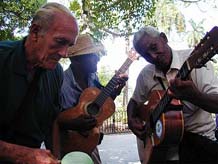
|
Getting to know people in Cuba provided
an opportunity to become at least a little familiar with their
culture, too -- the music especially. Great music was everywhere.
Traditional singers often performed to earn money from tourists,
like this group in Havana.
|
|
But there were no tourists in the
little village on Cayo Granma, an island in Santiago Bay, when
we came quietly rolling down the lane. These men and a few friends
were hanging out, singing and playing for their own enjoyment.
Mind you, as soon as they spied us, we became the audience so
they could earn something -- but the point is that the music was
part of their lives, not just a tourist attraction.
|

|

|
Virtually every town of any size
in Cuba has a casa de trova, house of song. These are government-supported
establishments where people come to play and hear traditional
music. This is the most famous casa de trova, in Santiago
de Cuba. Nearly all the great traditional musicians of Cuba have
played here at one time or another, and many of their portraits
hang on the walls.
|
|
We expected to hear traditional
music, and also salsa, Afro-Cuban jazz and so on, but this concert
band was something of a surprise. We stumbled across the outdoor
performance in Pinar del Rio city. The musicians showed up at
a little park lugging their instruments, chairs, and music stands,
gave a free concert, and dispersed. They were extraordinarily
good!
|
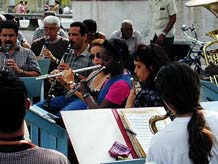
|
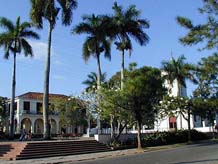
|
As well has having a casa de
trova, house of song, most towns have a casa de cultura,
a house of culture. These are venues for chamber music, art exhibits,
readings and other events. This is the casa in the small
Pinar del Rio town of Vinales.
|
|
There is a lot of street art in
Cuba. This mural in Pinar del Rio city makes a statement about
the adverse effects of tourism and consumer culture on Cuba's
environment. In the upper left, riding atop the giant gusano
(worm, slang for Miami exiles -- or perhaps it's an oil
pipeline) is a tourist bus wearing sunglasses, towing a US dollar
and lots of the junk that comes in its wake. A glass jar, which
protects Cuba's natural beauty, is being shattered.
|
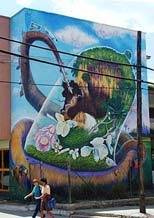
|
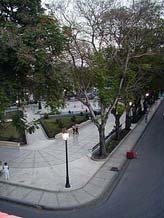
|
There seems to be a powerful sense
of community in Cuba, a sense of the nation as a family. When
this photo was taken at the town square in Bayamo, several pigs
were being roasted nearby. Chairs and tables were soon set out
on the sidewalks. After dark, the square filled with people --
children playing with balloons at 10:00 p.m., little carts pulled
by goats circling round the square, taking the children for rides
-- and always, loud music from every direction. It seemed that
everyone in town was there, and it was a regular Saturday night
event.
|
|
In the morning, there were music,
games, and competitions in the square for children from the local
elementary schools. There was a casa de cultura on the
square, also a computer club for kids, and a casa de trova
just a block away. We thought these things contribute to the quality
of life and the sense of community in Cuba, even though life may
be terribly hard in other ways.
|
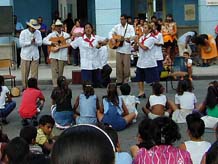
|
|





